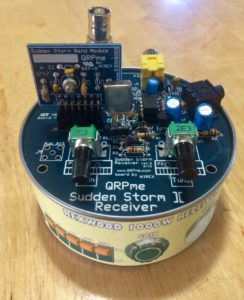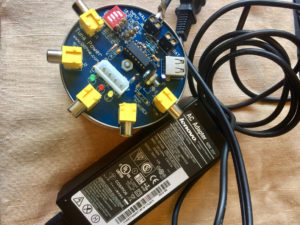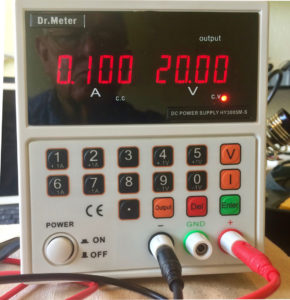At our previous address I built a 40 meter dipole that worked somewhat well. I was able to make a few contacts even though the band conditions over the summer were very poor. At least the afternoon Hawaii net on 40 meters was workable. The antenna apex was about 25′ above the ground and the legs in a sloping inverted V configuration coming down to about 10′ above the ground. The antenna was oriented northwest to southeast which would put the major lobes towards North America and towards New Zealand and Australia. The SWR measured between 1.3:1 to 1.5:1 across the 40-meter band. It also had similar SWR on 15-meters.
Then came the requirement to move. I tried to put the same antenna up here. Because of limited places to guy the painter pole holding the apex of the antenna, I was only able to get it about 18′ above the ground. The legs were again in an inverted V configuration, but also angled away from the antenna. Rather than having a 180° spread, the angle was closer to 150° on one side and 210° on the other. The antenna also was in an east/west orientation, meaning the main lobes (what there was of them) went north and south. Further, at that height, the takeoff angle was no lower than 60° making the antenna at best NVIS. The legs were attached to an 8′ 2×2 board velcro’d to the fence and had to go through quite dense foliage. I had 50′ of Radio Shack RG-8u coax to go from my Yeasu FT-897D to a 1:1 current balun at the apex of the antenna, meaning that about 30′ of coax was coiled on the floor behind the radio.
The SWR was horrible; resonance was 7.045 Mhz with an SWR of 7.3:1, too high for the built-in tuner to accommodate. I have an MFJ-971 portable tuner that I bought to use with my (still in the box, not yet powered up) Xiegu X1M Pro QRP transceiver. With that I was able to bring the SWR into a more reasonable range, but the SWR fluctuated across a very wide range from the wind in the foliage. Further, the coil of coax was also acting as an inductor with a lot of capacitance further screwing up the signal. I then picked up at 20′ piece of Radio Shack RG-8u coax, that improved the power output considerably, but the FT-897D did not like the SWR fluctuation at all. The antenna was simply non-functional. Down it came.
As an aside, we have an excellent Radio Shack about a half-hour away to the northwest in Hale’ewa. This is one of about ten still open stores in Oahu, but the only one that actually stocks parts. All the other stores are concentrating on selling cell phones and audio cables with literally no other stock. The store in Hale’ewa, however, keeps a fully stocked parts section. I love that store!
I have a Buddipole antenna system, the “long” version. It works very well, but takes me a half hour to get set up, guyed down, and tuned. It’s not at all advisable to leave this antenna up in the Hawaiian salt air / volcano ash / frequent rain showers weather. That was the reason for thinking about putting up a 40-meter dipole so when I had a few minutes I could sit down at the radio and see what was happening. As we move into “winter” (a strange term in Hawaii), band conditions will favor 40 and 80 meters.
I may still try to find a way to get a north/south orientation and trim that 40-meter dipole down into a 20-meter configuration. A 20-meter dipole is quite a bit shorter … we’ll see. We’re only here in Hawaii for 4 more months and then will be moving back stateside.


